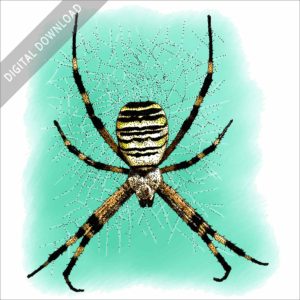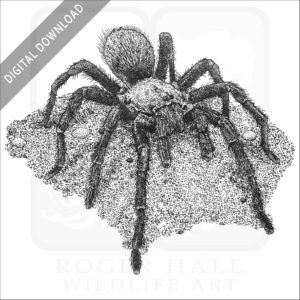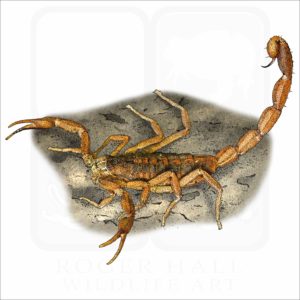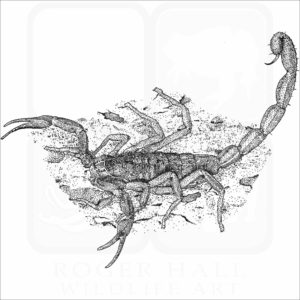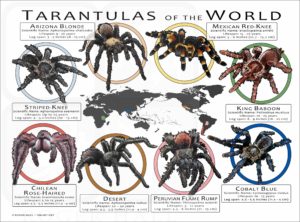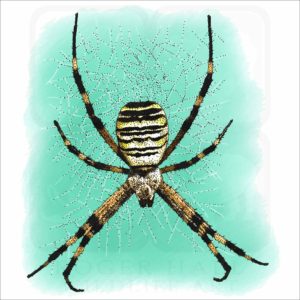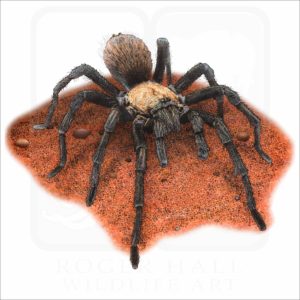Stock Art Drawing of a Wasp Spider
Medium: Pen and ink line art illustration. Color image has been digitally tinted.
Suggested usage: books, magazines, brochures and similar.
Size: (B&W) 2036 x 2400 pixels @ 300dpi 1.61 mb JPEG File / (Color) 2047 x 2400 pixels @ 300dpi 2.39 mb JPEG
Buy a Signed Print
Select options
This product has multiple variants. The options may be chosen on the product page
Stock Art Drawing of a Western Desert Tarantula
Medium: Pen and ink line art illustration. Color image has been digitally tinted.
Suggested usage: books, magazines, brochures and similar.
Size: (B&W) 2400 x 1240 pixels @ 300dpi 1.17 mb JPEG File / (Color) 2400 x 1248 pixels @ 300dpi 1.90 mb JPEG
Buy a Signed Print
Select options
This product has multiple variants. The options may be chosen on the product page
Tarantula Species of the World Poster Print
Tarantulas are a group of hairy arachnids of the family Theraphosidae. As of 2022, roughly 1,040 species have been identified. These large spiders are found on every continent except Antarctica. While they are venomous and can deliver a painful bite, this venom is fairly weak and no fatalities have ever been verified.
List of species:
ARIZONA BLONDE TARANTULA (Aphonopelma chalcodes)
CHILEAN ROSE-HAIRED TARANTULA (Grammostola rosea)
COBALT BLUE TARANTULA (Cyriopagopus lividum)
DESERT TARANTULA (Aphonopelma iodius)
KING BABOON TARANTULA (Pelinobius muticus)
MEXICAN RED-KNEE TARANTULA (Brachypelma smithi)
PERUVIAN FLAME-RUMP TARANTULA (Thrixopelma ockerti)
STRIPED-KNEE TARANTULA (Aphonopelma seemanni)
FREE SHIPPING IN THE US
Select options
This product has multiple variants. The options may be chosen on the product page
Wasp Spider – Signed Fine Art Print
Fine art illustration of a Wasp Spider (Argiope bruennichi.)
The poster is printed on matte, museum-quality paper with Giclée printing quality:
• Paper thickness: 10.3 mil • Paper weight: 5.6 oz/y² (192 g/m²) • Opacity: 94% Buy a Digital Download
Select options
This product has multiple variants. The options may be chosen on the product page
Western Desert Tarantula – Signed Fine Art Print
Information about the Western Desert Tarantula:
The Western Desert Tarantula -also called the Arizona Blonde Tarantula or Mexican blond tarantula - is of the genus Aphonopelma. It has a limited distribution in the deserts of Arizona and adjacent parts of Mexico but can be very common within this range. The name "blond tarantula" refers to the carapace, which is densely covered in pale hairs and contrasts strongly with the all-dark legs and abdomen. The spider can grow to be between 3 to 10 inch (7 to 25 cm) While it is a burrowing spider, it is often seen during the summer rainy season in southwestern deserts. The female is usually a uniform tan color, whereas the males have black legs, a copper-colored cephalothorax and a reddish abdomen. Their burrows can be as large as 1 to 2 inches (25 to 50 mm) in diameter, with some strands of silk across the opening. The tarantula is usually found in saguaro cactus dominated plant communities. Like other tarantulas, they are nocturnal predators that never venture far from their burrows unless it is to find a mate. In winter they plug their burrows with soil, rocks, and silk and survive in a relatively inactive state. During this time the animals live off stored fat reserves. Tarantulas have an interesting defensive capability in addition to venom. Some of the hairs on the top of the abdomen are specialized for defense. These urticating hairs, as they are called, are tipped with backward pointing barbs. If a tarantula is threatened in any way, it brushes these hairs into the face, paw or other body part of its attacker. Once these hairs are embedded, they are irritating and very difficult to remove because of the barbs.The poster is printed on matte, museum-quality paper with Giclée printing quality:
• Paper thickness: 10.3 mil • Paper weight: 5.6 oz/y² (192 g/m²) • Opacity: 94% Buy a Digital Download
Select options
This product has multiple variants. The options may be chosen on the product page

